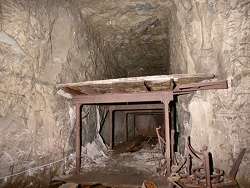World War II Bunkers
Air Raid Shelters

The necessity to build bunkers against air raid started with the development of aircraft good enough to transport a heavy load of bombs over an appropriate distance. This happened first during World War II. The aircraft of World War I were still primarily used for air reconnaissance and for fights one on one.
As the invention of heavy bombers was a general invention of numerous countries, they also tried to build bunkers for defense. They should house vital infrastructure and save it from air raids. Some bunkers were military bunkers for the General Staff, others were used to store valuables or art. Some bunkers were intended for the safety of high personalities, others for organizing a battle. And very common were bunkers used for weapon and armament factories.
But most of the bunkers were used for people, they had to run to the next bunker when the siren signaled air raid alarm. To find them easily, the bunkers were signposted. Many houses simply had a cellar renamed bunker, but some cities with vast underground cellar systems or mine shafts had very good air raid shelters. Other cities created concrete bunkers, which were then covered by a few meters of soil. Some bunkers were built above ground with very thick concrete walls. Unfortunately, many of those bunkers were rather unsafe. If the house above was destroyed, the entrances were often covered by piles of debris. The people could not leave them any more, and so many had to die of suffocation. Or they collapsed from the weight. A common countermeasure was to connect different cellars with tunnels, so if at least one of many entrances was not blocked, people could leave the bunker again.
All those underground shelters were intended to seat the people for a few hours while bombs were falling. The main purpose was to resist the explosions and the dangerous fragments. So it was not necessary to stay inside the bunker after the end of the air raid. As a result, they were equipped only with the minimum. People had packed suitcases with some basic things which they took with them to the bunker. Probably something to eat and drink, probably a book or some toys for the children.
- Examples
 Bergbaumuseum Klagenfurt, Austria
Bergbaumuseum Klagenfurt, Austria Mount Isa Underground Hospital and Museum, Australia
Mount Isa Underground Hospital and Museum, Australia Festungsmuseum Crestawald, Switzerland
Festungsmuseum Crestawald, Switzerland Festung Fürigen, Switzerland
Festung Fürigen, Switzerland Festung Heldsberg, Switzerland
Festung Heldsberg, Switzerland La Claustra Hotel, Switzerland
La Claustra Hotel, Switzerland Fort de Litroz, Switzerland
Fort de Litroz, Switzerland Le Fort de Pré-Giroud, Switzerland
Le Fort de Pré-Giroud, Switzerland Festungsmuseum Reuenthal, Switzerland
Festungsmuseum Reuenthal, Switzerland Festung Vitznau, Switzerland
Festung Vitznau, Switzerland Berliner Unterwelten, Germany
Berliner Unterwelten, Germany Bunkermuseum Hamburg, Germany
Bunkermuseum Hamburg, Germany Führerbunker, Germany
Führerbunker, Germany Hausertorstollen, Germany
Hausertorstollen, Germany Bunker am Kap Arkona, Germany
Bunker am Kap Arkona, Germany Nürnberg Art Bunker, Germany
Nürnberg Art Bunker, Germany Villa Fliedner, Germany
Villa Fliedner, Germany Westwallmuseum Bad Bergzabern, Germany
Westwallmuseum Bad Bergzabern, Germany Westwallmuseum Irrel, Germany
Westwallmuseum Irrel, Germany Westwallmuseum Pirmasens, Germany
Westwallmuseum Pirmasens, Germany Silkeborg Bunker Museum, Denmark
Silkeborg Bunker Museum, Denmark Atlantikwall, France
Atlantikwall, France Le Blockhaus d’Eperlecques, France
Le Blockhaus d’Eperlecques, France Musée de l’Abri de Hatten, France
Musée de l’Abri de Hatten, France La Coupole, France
La Coupole, France La Forteresse de Mimoyecques, France
La Forteresse de Mimoyecques, France Simserhof, France
Simserhof, France Siracourt VI Storage Bunker, France
Siracourt VI Storage Bunker, France Wellington Caves, France
Wellington Caves, France Battle of Britain Control Room, Great Britain
Battle of Britain Control Room, Great Britain Cabinet War Rooms, Great Britain
Cabinet War Rooms, Great Britain Paddock - Churchill’s Secret Bunker, Great Britain
Paddock - Churchill’s Secret Bunker, Great Britain Fort Hommet Gun Casemate, Great Britain
Fort Hommet Gun Casemate, Great Britain German Naval Signals Headquarters, Great Britain
German Naval Signals Headquarters, Great Britain German Underground Hospital, Great Britain
German Underground Hospital, Great Britain Hellfire Corner, Great Britain
Hellfire Corner, Great Britain Jersey War Tunnels, Great Britain
Jersey War Tunnels, Great Britain La Valette Underground Military Museum, Great Britain
La Valette Underground Military Museum, Great Britain Noirmont Command Bunker, Great Britain
Noirmont Command Bunker, Great Britain Porthcurno Telegraph Museum, Great Britain
Porthcurno Telegraph Museum, Great Britain St Peter’s Bunker Museum, Great Britain
St Peter’s Bunker Museum, Great Britain Victoria Tunnel, Great Britain
Victoria Tunnel, Great Britain Western Approaches Command Centre, Great Britain
Western Approaches Command Centre, Great Britain Sziklakórház Múzeum, Hungary
Sziklakórház Múzeum, Hungary Lubang Jepang, Indonesia
Lubang Jepang, Indonesia Museo della Miniera Massa Marittima, Italy
Museo della Miniera Massa Marittima, Italy Kleine Berlin, Italy
Kleine Berlin, Italy Rifugio Antiaereo Martana, Italy
Rifugio Antiaereo Martana, Italy Shelter No. 20, Japan
Shelter No. 20, Japan Schuilen in Maastricht, Netherlands
Schuilen in Maastricht, Netherlands The Vault, Netherlands
The Vault, Netherlands Sydvaranger Mine, Norway
Sydvaranger Mine, Norway Andersgrotta, Norway
Andersgrotta, Norway Ojukwu Bunker, Nigeria
Ojukwu Bunker, Nigeria Voice of Biafra Bunker, Nigeria
Voice of Biafra Bunker, Nigeria Fort Bonifacio Tunnel, Philippines
Fort Bonifacio Tunnel, Philippines Malinta Tunnel, Philippines
Malinta Tunnel, Philippines Anlage Mitte, Poland
Anlage Mitte, Poland Pętla Boryszyńska, Poland
Pętla Boryszyńska, Poland Międzyrzecki Rejon Umocniony (Ostwall), Poland
Międzyrzecki Rejon Umocniony (Ostwall), Poland Stalin’s Bunker, Russia
Stalin’s Bunker, Russia
- See also
 Search DuckDuckGo for "World War II Bunkers"
Search DuckDuckGo for "World War II Bunkers" Bunker - Wikipedia (Wed Mar 30 2011 13:35:02 GMT+0200)
Bunker - Wikipedia (Wed Mar 30 2011 13:35:02 GMT+0200) World War 1 and World War 2 Bunkers and Underground Structures (Wed Mar 30 2011 13:34:52 GMT+0200)
World War 1 and World War 2 Bunkers and Underground Structures (Wed Mar 30 2011 13:34:52 GMT+0200) Bunker Pictures - bunkerpictures.nl - atlantikwall, bunkers, world war two, cold war (Wed Mar 30 2011 13:35:22 GMT+0200)
Bunker Pictures - bunkerpictures.nl - atlantikwall, bunkers, world war two, cold war (Wed Mar 30 2011 13:35:22 GMT+0200)

 Index
Index Topics
Topics Hierarchical
Hierarchical Countries
Countries Maps
Maps